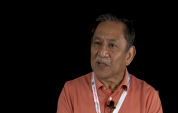4:11 | After coming home from Germany, Ayson was assigned back to Fort Rucker and then Fort Lewis. He had to have open heart surgery, which disqualified him from flying anymore. As a result of this, he retired from his military duties and instead got a job in the postal service. He gives his reflections about the Vietnam War as a whole and how nice it is to engage in military reunions every now and then.
Keywords : Edward Ayson Fort Lewis surgery retired military postal service reflection Michael Novosel safety officer computer Saigon Vietnam Vietnam mentor warrant officer flight school Fort Rucker

After getting wounded in his first Vietnam tour, Ayson got out of the hospital and went to flight school. After that he was sent to medevac school to learn how to become part of an aircraft rescue medical team. He explains exactly what a medevac team is and does for those who may not know. From there he had his second tour in Vietnam, helping rescue as many injured infantry men as he could.
Edward Ayson's family is originally from the Philippines, but he was born and grew up in Hawaii. His family was deeply affected by the Pearl Harbor attack and World War II as a whole. By the time Ayson was 18, he was drafted and began training at Schofield Barracks, spent four years in Germany, more time in Hawaii, and eventually began his first tour in Vietnam. Shortly after, he got a gunshot wound and was taken out of combat.
While on his second tour, Ayson was in contact with gunships that had run out of ammo while he had to pick up a number of wounded, so he was forced to wait until they refueled to pick them up. He didn't have a lot of interaction with the patients, but he does recall a time he tried to talk to one of them. There were times where he even picked up wounded from the Viet Cong or North Vietnamese Army. He also talks about what duties he had while not on rescue missions, such as data organization and filling out paperwork.
One time Ayson and his crew had to rescue ARVNs, or members of the Army of the Republic of Vietnam. He remembers there were multiple deserters trying to climb aboard his aircraft during the rescue, and as he was taking off one of them fell off the wing. He also talks about a particular hoist mission to rescue an injured non-commissioned officer. After his second tour in Vietnam was up in 1970, he chose to come home because he had gotten married and wanted to be reunited with his wife.